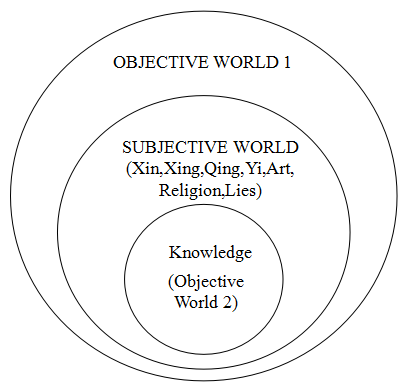




8.3 Dialectical Relation of Two Worlds
There are the sun, the moon, the stars, tables, chairs and human society in the objective world, and there is the human brain, the movement of brain and the consciousness generated by brain movement. Human consciousness produces the
subjective world, in which there is what I see and think. I see tables and chairs, I see people and their behaviors, I see the sun, the moon and the stars, I think of the Big Bang, I think of the wave-particle duality of light and so on. These things constitute the objective world, which is inside the subjective world. This objective world is objective world 2. The real objective world is objective world 1.

Figure 2. Dialectical Relation of the Two World.
The objective world we think and talk about is not the real objective world, but is made of our experience, ideas and theories. Now let’s look at the objective world 1. Is the objective world 1 really objective? The objective world 1 we’re talking about here is also something we’re thinking about. I wouldn’t be able to say it if I hadn’t thought about it. Now that I’m thinking and talking about the objective world 1, it is also part of the subjective world, essentially it is objective world 2. That is to say, there is a subjective world outside the objective world 1, and there is an objective world outside the subjective world. And so on, layer upon layer nesting, endless loop. The relation between the subjective world and the objective world belongs to the dialectical unity relation, or the relation between matter and consciousness is the dialectical unity relation. Laozi said, "Tao is a Yin and a Yang." This is the world view of dialectical dualism, the most fundamental and overall world view that metaphysics of philosophy should present to the public.
The person in the picture below is holding an image. In the image there is a person, herself, who is holding the same image, in which there are smaller images, and so on and so on. This also happens when looking at a mirror, with another mirror placed opposite. You can see an infinite number of mirrors reflecting off each other. This is called the Droste effect, a visual form of recursion.

Figure 3. Droste Effect.
Dialectical logic does not conform to the rules of formal logic, but it is the commonness of many things, which is a logical relationship that we have to admit. Phenomena such as Droste effect, Klein bottle and Mobius belt all provide visual images of dialectical unity relations. The upper and lower sides of the Mobius belt are connected, and the inner and outer sides of the Klein bottle are connected.



Figure 4. Klein Bottle, Mobius Belt, Yin Yang Diagram of Taiji Theory.
This relation of dialectical unity is not new to us, and many people are aware of its profound philosophical significance. But what it means, no one has been able to describe clearly. This dialectical view of the world did not become the most fundamental overall view of the world that metaphysics of philosophy should present to the public. The Chinese ancient idea of Taiji Yin Yang is similar to this world view, but it did not said that the Yin and Yang represent the subjective world and objective world.